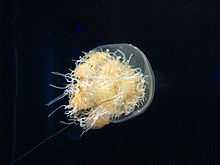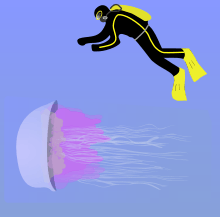Nomura's jellyfish
| Nomura's Jellyfish | |
|---|---|
 | |
| Nemopilema nomurai in the Kaiyūkan-aquarium of Ōsaka | |
 | |
| Size comparison of a Nomura's jellyfish next to a diver | |
| Conservation status | |
| Not evaluated (IUCN 3.1) | |
| Scientific classification | |
| Kingdom: | Animalia |
| Phylum: | Cnidaria |
| Class: | Scyphozoa |
| Order: | Rhizostomae |
| Family: | Rhizostomatidae |
| Genus: | Nemopilema |
| Species: | N. nomurai |
| Binomial name | |
| Nemopilema nomurai (Kishinouye, 1922) | |
| Synonyms | |
|
Stomolophus nomurai | |
Nomura's Jellyfish (エチゼンクラゲ echizen kurage, Nemopilema nomurai) is a very large jellyfish, in the same size class as the lion's mane jellyfish, the largest cnidarian in the world. It is edible but not considered high quality.[1]
Overview

The diameter when fully grown is slightly greater than the height of an average man. The species was named in tribute to Mr. Kan'ichi Nomura (C18–C19), Director General of the Fukui Prefectural Fisheries Experimental Station, who in early December 1921 sent a specimen in a 72-litre wooden tank to Professor Kishinouye, who found that it was unknown and spent some time at the station to study living specimens.[2]
Growing up to 2 m (6.6 ft) in diameter and weighing up to 200 kg (440 lb),[3] Nomura's Jellyfish reside primarily in the waters between China and Japan, primarily centralized in the Yellow Sea and East China Sea.[4] Population blooms appear to be increasing with frequency in the past 20 years.[5] Possible reasons for the population increase in Nomura's Jellyfish include climate change, overfishing, and coastal modification adding substrate for asexually producing polyps.[4]
In 2009, a 10-tonne (11 ton) fishing trawler, the Diasan Shinsho-maru, capsized off Chiba on Tokyo Bay as its three-man crew tried to haul in a net containing dozens of Nomura's Jellyfish; the three were rescued by another trawler.[6][7]
References
- ↑ Kawahara, M., and M. N Dawson (2007). "Nemopilema nomurai - a big problem". The Scyphozoan. Retrieved 28 September 2013.
- ↑ Hansson, Hans G. "Biographical Etymology of Marine Organism Names. N & O". Tjärnö Marine Biological Laboratory. Retrieved 16 November 2009.
Drs Toyokawa Masaya & Kensuke Yanagi kindly informed about Kanichi Nomura
- ↑ Discovery News -- Monster Jellyfish
- ↑ 4.0 4.1 Uye, S., 2008. Blooms of the giant jellyfish Nemopilema nomurai: a threat to the fisheries sustainability of the East Asian Marginal Seas. Plankton and Benthos Research, 3 (Supplement): 125-131. http://www.plankton.jp/PBR/issue/vol03_suppl/03suppl_125.pdf
- ↑ Richardson, A.J., Bakun, A., Hays, G.C., and Gibbons, M.J. 2009. The jellyfish joyride: causes, consequences and management responses to a more gelatinous future. Trends in Ecology & Evolution, 24: 312-322.
- ↑ Foster, Joanna M. (2 February 2012). "Evidence for Jellyfish Invasion Is Lacking, Study Says". The New York Times.
- ↑ Ryall, Julian (2 November 2009). "Japanese fishing trawler sunk by giant jellyfish". London: Telegraph.co.uk. Retrieved 3 November 2009.
External links
![]() Media related to Nemopilema nomurai at Wikimedia Commons
Media related to Nemopilema nomurai at Wikimedia Commons
- Giant Echizen jellyfish off Japan coast, (BBC News, November 30, 2009)
- Giant Jellyfish Invade Japan (National Geographic)
- Giant jellyfish invade Japanese coast (Cambodian Online)
- Super blobs' deep impact (The Sydney Morning Herald)
- Chefs prepare for annual giant jellyfish invasion (Pink Tentacle)
- Japanese fishermen brace for giant jellyfish (CNN)
- The Age Of Jellyfish (spectre footnotes (blog), July 31, 2009)
- Giant Jellyfish Head North in Warming World, MSNBC